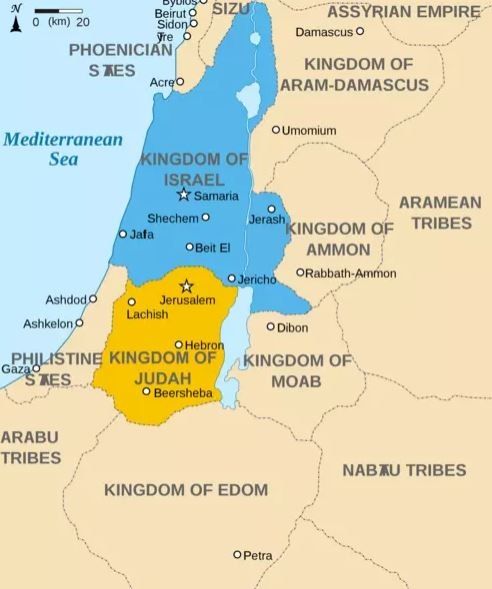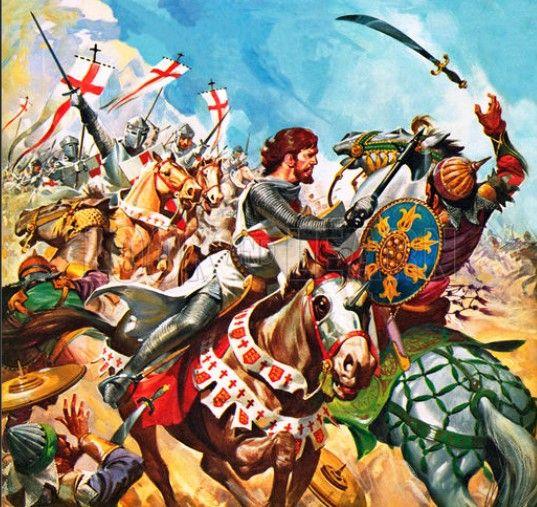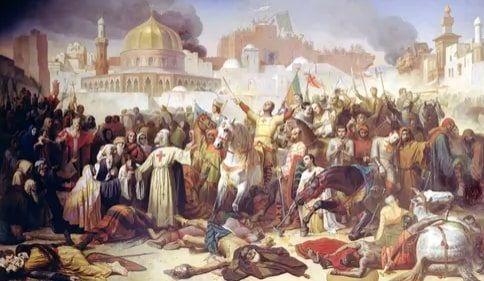INTUSK MAGAZINE
TO THE CORE OF YOUR HEART
The History of Canaan
February 10, 2023

In the ancient world, Palestine was part the region known as the Canaan, where the kingdom of Israel and the kingdom of Judah were located. The name Palestine was originally used to refer to territory in southern Canaan.
The so-called Philistines were sparsely populated among the Canaanites, Canaanite-Phoenicians, and Israelites. These Philistines located in an area known as Philistia on the southern coastal plain of the Mediterranean sea in 1276 BC. As far back as the 18th century, the whole region was known as the 'Canaan' in Mesopotamian texts and trade records. The word Palestine does not appear in any written record until the mention of Herodotus' Histories in the 5th century. After Herodotus, the term Palestine was used for the entire region formerly known as Canaan.
Human settlements in the region are thought to have existed as early as 10,000 BC. They could have migrated from Mesopotamia and were hunters but it is considered that they have turned to farming in the early bronze age.
Canaan became a prosperous region during the Middle Bronze Age (2000 BC-1550 BC) with trade with other nations, and as a result, the area came under Egyptian influence during the last Bronze Age.
As Egypt's influence and power waned, so did the Assyrians' influence. As far back as 1295, Assyrian invasions invaded other lands, and the Canaanites were not spared. According to Joshua's book, Joshua, an Israeli general, invaded the area and divided it among his people.
The region was subsequently conquered by the Assyrians, Babylonians, Persians, and Alexander the Great, and was eventually captured by Roman armies.
After the uprising of Bar-Cochba in 132-136 AD, Hadrian, the Roman emperor, renamed the area Syria-Palaestina, combining the names of the traditional enemies of the Jews, the Syrians and the Philistines, to punish the revolt of the Jewish people.
After the fall of the Western Roman Empire, the region was occupied by the Eastern or Byzantine Empire. In 634 it was ruled until it was invaded by Muslim forces from Arabia.
Name
The name 'Palestine' is derived from the word Plesheth, which symbolizes the immigrant tribe, or the name used by the Greeks to refer to the tribal Philistines.
It is further suggested that the term Palestine originated from Pals, a Canaanite deity. If so, then Palestine means 'Pals's land'. However, there is no record that this goddess has been associated with the name of this region since ancient times.
After Herodotus used the term in the 5th century, the name Palestine was gradually replaced by the name of the region, "Canaan."
Early history
This region is one of the earliest human settlements in the world. Archaeological evidence suggests that a tourist hunting tribal human society existed in the region before 10,000 BC. Permanent settlements began in the early Bronze Age, and gradually agricultural communities developed. In addition, trade with other parts of the Near East began, and this area became an important trading centre as it was located between the cities of Mesopotamia and Arabia and Egypt, attracting the attention of the Great Sargon (234-2279 BC). In 2300 BC it was annexed to the Akkadian Empire.
By this time, the wealth of the Akkadian Empire had encouraged the growth of urban centres throughout the region, and much of this territory lasted until the fall of the Akkadian Empire in 203 BC in the face of invading armies of the Gutians, Elamites, and Amorites. After this, the people left the cities and returned to a rural, peasant lifestyle, which may have been due to overcrowding, but the exact reasons for this are not clear.
Middle Bronze Age
During the Middle Bronze Age (2000 BC - 1550 BC), people re-embraced urbanization and trade flourished. International trade was first established between the port city of Byblos and Egypt in 4000 BC. By 2000, Egypt was the most powerful trading partner. The types of tombs included in the tombs and the influence of Egypt on the region's burial rituals are evident.
This partnership continued to benefit Egypt and the Palestinian Territories until the arrival of the Semitic peoples known as the Hyksos in 1725 BC.
Until their overthrow by Ahmose I of Thebes in 1570 BC, they were powerful enough to trade, mobilize troops, and control a large part of the Delta and Lower Egypt. Ahmos I's campaign led the Hyksos to pursue Syria through Palestine in the north.
The last Bronze Age
After the expulsion of the Hyksos, the cities of Palestine were rebuilt, and Ahmose I annexed the region to the newly formed Egyptian Empire (known as the New Kingdom, 1570 BC-1069 BC).
Ahmos wanted to create a security zone around Egypt's border to ensure that no other foreign forces entered Egypt's borders. Later pharaohs enlarged that defensive zone to establish their empire.
Some prominent Egyptian pharaohs ruled the new kingdom and sponsored Palestine through trade and building projects. Trade in the region by Hatshepsut (1479-1458 BC), Thutmose III (1458-1425 BC), Amenhotep III (1386-1353 BC) and Ramses the Great (1279-1213 BC) And improving its infrastructure are examples.
During the reign of Thutmose III, peace was disrupted by a mob called the Habiru. The identity of this community is unknown, but they appear to have belonged to the region, and the term 'habiru' was used to refer to those who refused to conform to the rules of society.
They have been described as more illegal than the invaders, and past attempts by modern scholars to associate Habiru with the Hebrews have been discredited.
During the reign of Ramses the Great, the sea people first appeared in the history of Egypt. In 1278 BC, Ramses defeated them in a sea battle off the coast.
In the Battle of Kadish in 1274 BC, these seafarers were reunited as allies of the Hittites. Who they were and where they came from is still debated today. They waged war against Egypt, during the reign of Meranthap (1213-1203 BC) and Ramses III (1186-1155 BC).
Their activities and the Assyrian invasion of 1300 BC plunged the eastern region into a web of chaos.
During this time, from 1250 BC-1200 BC, the conquest of Canaan by General Joshua of Israel is thought to have taken place according to biblical Joshua.
The first mention of Israel comes from Merenpta, who describes the victory over the Libyans (allies of the seafaring people) as "Israel is doomed." It does not refer to 'Israel' as a state or a city-state but as a people.
However, at some point after the invasion of General Joshua, the Israelites established a permanent settlement in the area, and by the end of the seventh century. In 1080 BC, the Kingdom of Israel was established in the north.
This was a united area until Samaria became Israel's capital and Jerusalem became the capital of the Kingdom of Judah, after the death of King Solomon (c. 965-931 BC).
During and after the reign of the early kings of Israel, the Philistines are repeatedly mentioned in the Bible as their arch-enemies.
Philistines and Foreign Invaders
With the invasion of the area by Ramses III of Egypt in 1276 BC, the Philistines settled on the southern Mediterranean coast of Canaan.
Other, older, settlements were already thriving in the area and the Philistines soon conquered them. According to biblical stories, the Philistines were organized and efficient enough to cause great trouble to the original tribes and cities in those areas.
They posed a significant threat to King Saul of Israel (1080-1010 BC) and were defeated by his successor, King David (1035-970 BC), even during the reign of King Solomon they were the enemies of Israel. Despite their defeat in Israel, the Philistines did not forget to continue harassing the neighbouring tribes.
In 722 BC the area was captured by the Assyrians and the kingdom of Israel was destroyed. At the same time, the Philistines were completely subdued and lost their independence. Palestine was belonged to Assyrian Empire ruled by their king Sennacherib (705-681 BC). In 703 he launched a war campaign in the region. Though he failed to capture Jerusalem, but managed to make Judah a vassal state.
The region was ruled by the Assyrians until the fall of the Assyrian Empire in 612 BC, and the Babylonians invaded and destroyed Jerusalem in 598 BC and took the Israelite leader to Babylonia.59. Within the border, the Babylonians destroyed the rest of Judah and drove out the Philistine.
Babylon fell to Cyrus the Great in 530 BC and he annexed the area to the Achaemenid Empire and allowed the Jews to return to their homeland from Babylon.
The Persian Empire was conquered by Alexander the Great (356-323 BC), and was succeeded by the Seleucids who ruled until in 168 BC Maccabees rebelled against foreign rule and the imposition of foreign religions and established the last independent Jewish kingdom, the Hasmoniam dynasty.
In 63 BC Rome became involved in regional affairs, and after Augustus became emperor, Palestine became a province known as Roman Judea in 31 BC.
Judeo-Roman wars
The Romans, at their own discretion, installed King Herod the Great to rule the region and, like other provinces of the empire, taxed Judea. However, the people resented Roman rule and Roman settlements, and Judea became a particularly troubled region for Rome.
The first Judeo-Roman war broke out in 66-73 AD, and Titus destroyed Jerusalem.
Although the people of the land were free to practice their cultures and religious beliefs, they were still under Roman rule and wanted independence. In 115-117 AD there was a conflict known as the Battle of Kitos (named after the Roman general Lucius Quitus, who commanded the Roman armies). The conflict also ended with the Roman conquest and a relative peace.
However, the Bar-Cochba Rebellion (132-136 AD) in 132 caused severe damage to both sides, killing more than 500,000 Jewish militants.
Emperor Hadrian was so outraged by the anti-Semitism that he named the province Syria Palestine.
He exiled all the Jews from that region and built his city Eliah Capitolinia on the ruins in Jerusalem. The Bar-Cochba Rebellion was the culmination of the Judeo-Roman War, and Rome later occupied the region without further incident.
Emperor Diocletian (284-305 AD) divided the Roman Empire into the Western Empire that ruled Europe and the Eastern Empire (later known as the Byzantine Empire).
When Emperor Constantine the Great (306-337 AD) legalized Christianity and made it the state religion, Syria-Palestine became a Christian province and an important centre for the new faith.
The Western Roman Empire collapsed in 476 AD, but the Byzantine Empire wasn't challenged until the 7th century and the rise of Islam in the region. In 634 AD, the Arab Muslim army captured Syria-Palestine and renamed it Jund Filastin ("Palestinian Military District").
The Muslims converted the Jewish and Christian churches in the area into mosques.
This area was called the Holy Land by European Christians and in 1096 AD the First Crusade was launched to retake it from the Muslim invaders. This endeavour, undertaken by many others with the support of the Byzantine Empire in 1272 AD, cost enormous lives and property, but in the end, received nothing. The Byzantine Empire collapsed in 1453 AD, greatly diminishing the Christian influence in the region. The area was subsequently occupied by the Ottoman Turks.
During the First World War, until the annexation of the British in 1915, the region continued to be plagued by wars for the next few centuries. Until World War II, Palestine was a war-torn and highly competitive region. The United Nations later declared the area Israel and established it as the homeland of the Jewish people.




